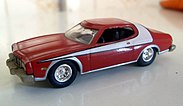1:64 scale
This article needs additional citations for verification. (December 2010) |
The 1:64 scale is a traditional scale for models and miniatures, in which one unit (such as an inch or a centimeter) on the model represents 64 units on the actual object. It is also known as the "three-sixteenths scale" since 3/16 of an inch represents one foot. An average human is approximately 1+1⁄16 inches (27 mm) tall when represented in 1:64 scale.
Popularity
The 1:64 scale originated by halving the common 1:32 scale, which was known as "standard size" in some hobbies.
This smaller scale became successful because of its relative size in comparison to other toys, the fact that it is a derivative of the 1/16 scale, and because small hands easily hold them.[1] The 1/64 scale models will generally have less detail than a 1/16 scale models.[1] Moreover, "1/64 coincides with the S scale of model railroading, part of the consideration of why 1/64 became an established size."[1]
Currently, the 1:64 scale is most commonly used for automobiles and other vehicle models. It is also a popular scale for model railroads and toy trains and has been used for ship models. In addition, 28mm military and fantasy figures are a popular size for tabletop gaming. They are sometimes scaled out to 1:64, although opinions on the actual scale of 28mm range from 1:48 to 1:64, with 1:56 being the most common.
Die-cast vehicles
Many die-cast automobiles and commercial vehicle models for collectors have been made to a strict scale of 1:64. However, for much of the
.Outside the US, brands like
Model horses
Breyer Animal Creations's brand Mini Whinnies, introduced in 2005, are the smallest scale of Breyer model horses at 1 1/2" high for adults and 1" for foals (1:64 scale). Initially produced by Creata Winner's Choice and sculpted by Candance Liddy, they are aimed at young collectors and usually sold in easy-to-carry packages and playsets; they are currently sold as blind bags.[2][3]
Slot cars

Small-scale slot cars are often sized to fit a standard motorized chassis and, thus vary somewhat in scale.
The mechanisms have increased in size over the years to generate more power. The so-called "HO" sized slot cars, introduced in the 1960s at about
Pictured is an early example of an approximately 1:64 slot car built by Aurora around 1972, as part of its AFX line. This first-generation AMC Matador coupe NASCAR race car replica is designed to fit on an enlarged chassis for a nominal HO track.
The 1:64 slot car lines include Micro Scalextric from the maker of the pioneering 1:32 scale slot cars. Tomy-Aurora and Life-Like also produced cars that average close to 1:64. Mattel's die-cast Hot Wheels Racing series and the Winner's Circle also have made die-cast scenes of 1/64-scale pit crews and race officials that look right with the appropriate NASCAR slot car models.[4]
Wargaming
Metal figures for tabletop
Model trains

From the late 1940s to the mid-1960s, 1:64 was a popular scale in the U.S. model railroad market, called
Since the 1930s, O scale (1:48) train manufacturers, including Gilbert, Lionel, and Marx, have produced bargain or introductory lines of undersized toy trains to run on O-gauge track with very tight curves, known as 0-27 track. Though sold as an O gauge, the bodies of these undersized cars and engines were often scaled to 1:64 proportions. The origins of Gilbert's S-gauge equipment can be traced to its American Flyer O-27 line of 1938 and after.
Ships and boats
Kit manufacturers have used 1:64 as a scale for boats and small ships.
See also
References
- ^ ISBN 978-0-89658-511-9. Retrieved 27 February 2011.
- ^ "Mini Whinnies - Series 3 - Individual Bag".
- ^ "Identify Your Breyer - Mini Whinnies Molds".
- ISBN 978-0-7603-1024-3. Retrieved 27 February 2011.




